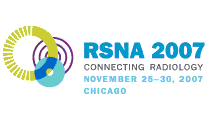
Abstract Archives of the RSNA, 2007
Eric E. Sauerbrei MD, Presenter: Nothing to Disclose
1. Define fetal soft markers. 2. List and describe the fetal soft markers that are evaluated in second trimester sonography. 3. For each marker, define the increased risk of fetal chromosomal abnormality. 4. For each isolated marker (i.e. no other fetal abnormality detected in the sonogram), indicate the appropriate clinical recommendation, based on the ultrasound finding and the background risk of fetal chromosomal abnormality.
In second trimester sonography (usually 16 to 20 weeks gestation), several ultrasound findings are associated with increased risk of fetal chromosomal abnormalities. These are distinct from fetal structural malformations or growth restriction, both of which are associated with increased genetic and perinatal risks.
Soft markers that have been associated with fetal aneuploidy and that are routinely assessed in second trimester sonography include: thickened nuchal fold, echogenic bowel, echogenic intracardiac focus, mild pyelectasis, choroid plexus cysts, mild ventriculomegaly, short femur, and short humerus. When a fetal soft marker is detected in isolation (i.e. no other fetal abnormality is detected in the sonogram), the risk of fetal aneuploidy is increased. This increased risk is quantified by the liklihood ratio(LR) of the marker. For example, if there is an isolated thickened nuchal fold, the LR of this marker for Trisomy 21 is about 9.8. The individual risk is the LR times the Background Risk. If there are no other risk factors from the history or previous testing, then the Background Risk for Trisomy 21 is estimated by knowing the maternal age and gestational age(see Table in handout). For a 25 year old woman at 16 weeks gestation, the Background Risk is about 1/1000. The Indivdual Risk for Trisomy 21 is (9.8 x 1/1000) or 1/102 (LR x Background Risk).
In the presentation, each fetal soft marker will be defined and illustrated. Based on the Liklihood Ratios derived from the literature, the clinical significance of each marker will be discussed. This will form the basis for specific recommendations that may be included in the report of the second trimester sonogram.
Sauerbrei, E,
Fetal Soft Markers. Radiological Society of North America 2007 Scientific Assembly and Annual Meeting, November 25 - November 30, 2007 ,Chicago IL.
http://archive.rsna.org/2007/5000191.html

